2018 PEUGEOT 5008 weight
[x] Cancel search: weightPage 225 of 364
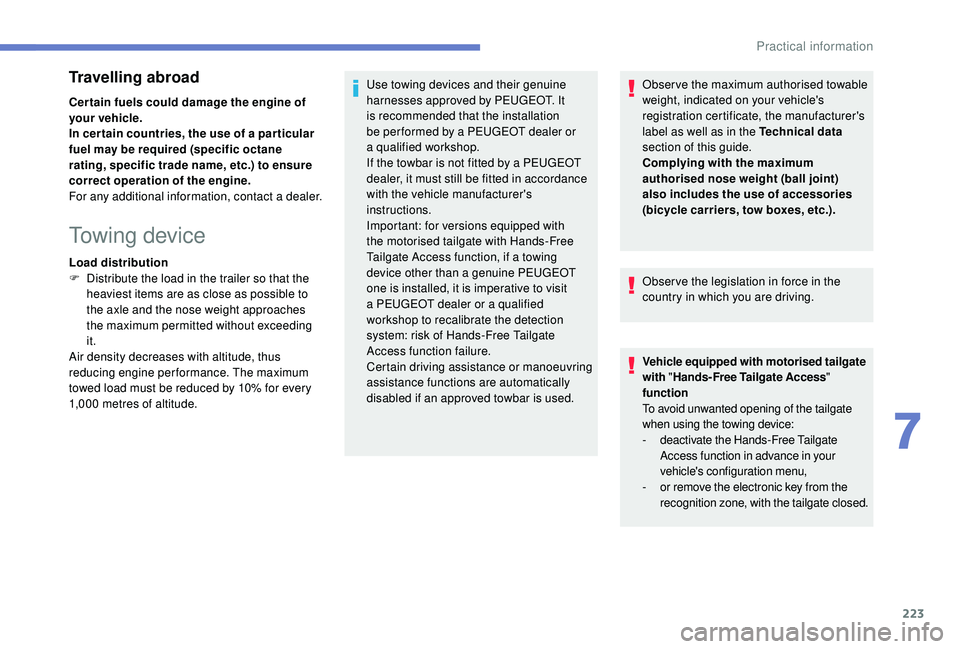
223
Travelling abroad
Cer tain fuels could damage the engine of
your vehicle.
In cer tain countries, the use of a par ticular
fuel may be required (specific octane
rating, specific trade name, etc.) to ensure
correct operation of the engine.
For any additional information, contact a
dealer.
Towing device
Load distribution
F D istribute the load in the trailer so that the
heaviest items are as close as possible to
the axle and the nose weight approaches
the maximum permitted without exceeding
it.
Air density decreases with altitude, thus
reducing engine performance. The maximum
towed load must be reduced by 10% for every
1,000
metres of altitude. Use towing devices and their genuine
harnesses approved by PEUGEOT. It
is recommended that the installation
be per formed by a
PEUGEOT dealer or
a
qualified workshop.
If the towbar is not fitted by a PEUGEOT
dealer, it must still be fitted in accordance
with the vehicle manufacturer's
instructions.
Important: for versions equipped with
the motorised tailgate with Hands-Free
Tailgate Access function, if a towing
device other than a genuine PEUGEOT
one is installed, it is imperative to visit
a
PEUGEOT dealer or a qualified
workshop to recalibrate the detection
system: risk of Hands-Free Tailgate
Access function failure.
Certain driving assistance or manoeuvring
assistance functions are automatically
disabled if an approved towbar is used. Obser ve the maximum authorised towable
weight, indicated on your vehicle's
registration certificate, the manufacturer's
label as well as in the Technical data
section of this guide.
Complying with the maximum
authorised nose weight (ball joint)
also includes the use of accessories
(bicycle carriers, tow boxes, etc.).
Obser ve the legislation in force in the
country in which you are driving.
Vehicle equipped with motorised tailgate
with "Hands-Free Tailgate Access "
function
To avoid unwanted opening of the tailgate
when using the towing device:
-
d
eactivate the Hands-Free Tailgate
Access function in advance in your
vehicle's configuration menu,
-
o
r remove the electronic key from the
recognition zone, with the tailgate closed.
7
Practical information
Page 226 of 364

224
Towbar with quickly
detachable towball
No tools are required to install or remove the
towball on this genuine towbar system.
Presentation
Trailers with LED lamps are not
compatible with the wiring harness of this
device.
1.
Carrier.
2. Protective plug.
3. Connection socket.
4. Safety eye.
5. Detachable towball.
6. Locking/unlocking wheel.
7. Security key lock.
8. Key reference label. A.
Locked position (the green marks are
opposite each other); the wheel is in
contact with the towball (no gap).
B. Unlocked position (red mark opposite
the green mark); the wheel is no longer
in contact with the towball (gap of around
5
m m). To know the Technical data
, and, in
particular, the towable weights for your
vehicle, refer to the corresponding section.
To ensure complete safety while driving
with a Towbar system
, refer to the
corresponding section.
Before each use
Check that the towball is correctly fitted,
verifying the follow points:
-
t
he green mark on the locking wheel
is in line with the green mark on the
towball,
-
t
he locking wheel is in contact with the
towball (position A ),
-
t
he security key lock is on and the key
removed; the locking wheel can no
longer be operated,
- t he towball must not be able to move in
its carrier; test by shaking it with your
hand.
If the towball is not locked, the trailer can
detach – accident risk!
Practical information
Page 227 of 364

225
Following use
When travelling without a trailer or load
on a
towbar-mounted carrier, the towball
must be removed and the protective plug
inserted in the carrier. This measure
applies particularly where the towball
might obscure visibility of the number
plate or its lighting.
Fitting the towballDuring use
Never release the locking system with
a
trailer or load carrier on the towball.
Never exceed the maximum authorised
weight for the vehicle – the Gross Train
Weight or GTW.
It is essential that the maximum
authorised load be complied with on the
towing device: if it is exceeded, this device
may detach from the vehicle, which is
a
serious accident risk.
Check that the trailer lamps work
c o r r e c t l y.
Before setting off, check the adjustment of
the headlamp beam height.
For more information on Headlamp
adjustment , refer to the corresponding
section. F
B
elow the rear bumper, remove the
protective plug 2
from the towball carrier 1.
F
I
nsert the end of towball 5 into carrier 1 and
push it upwards; the locking will take place
automatically. F
T
he locking wheel 6 turns a quarter of
a
turn anti-clockwise; take care to keep your
hands clear!
F
C
heck that the mechanism has correctly
locked in to place (position A ).
F
C
lose the lock 7 using the key.
7
Practical information
Page 268 of 364
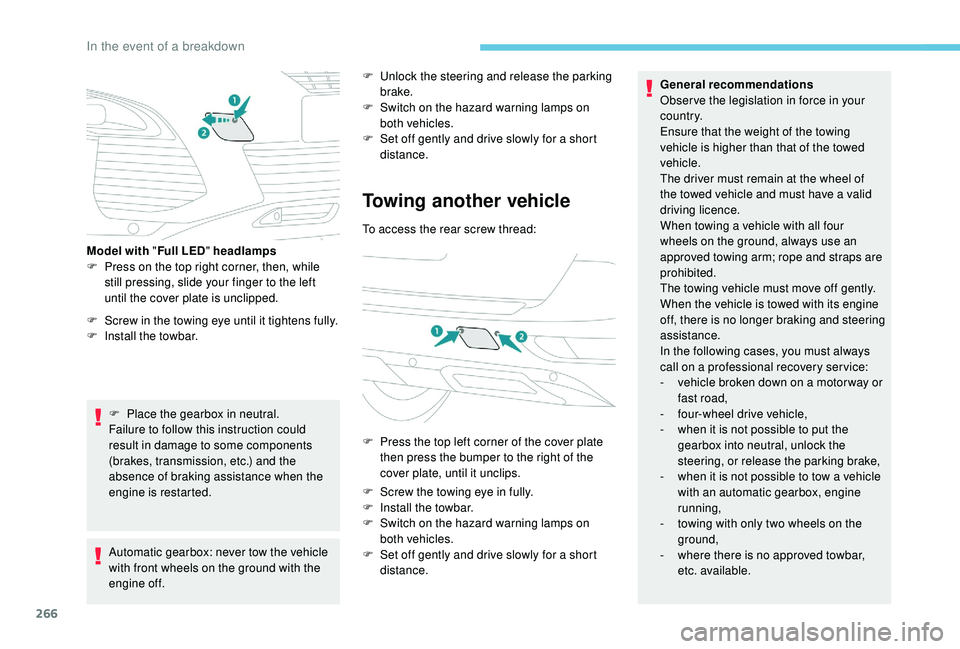
266
F Screw in the towing eye until it tightens fully.
F I nstall the towbar.
F
P
lace the gearbox in neutral.
Failure to follow this instruction could
result in damage to some components
(brakes, transmission, etc.) and the
absence of braking assistance when the
engine is restarted.
Model with "
Full LED" headlamps
F
P
ress on the top right corner, then, while
still pressing, slide your finger to the left
until the cover plate is unclipped.
Automatic gearbox: never tow the vehicle
with front wheels on the ground with the
engine off. F
U
nlock the steering and release the parking
brake.
F
S
witch on the hazard warning lamps on
both vehicles.
F
S
et off gently and drive slowly for a short
distance.
Towing another vehicle
To access the rear screw thread:
F
P
ress the top left corner of the cover plate
then press the bumper to the right of the
cover plate, until it unclips.
F
S
crew the towing eye in fully.
F
I
nstall the towbar.
F
S
witch on the hazard warning lamps on
both vehicles.
F
S
et off gently and drive slowly for a short
distance. General recommendations
Obser ve the legislation in force in your
c o u nt r y.
Ensure that the weight of the towing
vehicle is higher than that of the towed
vehicle.
The driver must remain at the wheel of
the towed vehicle and must have a
valid
driving licence.
When towing a vehicle with all four
wheels on the ground, always use an
approved towing arm; rope and straps are
prohibited.
The towing vehicle must move off gently.
When the vehicle is towed with its engine
off, there is no longer braking and steering
assistance.
In the following cases, you must always
call on a
professional recovery ser vice:
-
v
ehicle broken down on a motor way or
fast road,
-
f
our-wheel drive vehicle,
-
w
hen it is not possible to put the
gearbox into neutral, unlock the
steering, or release the parking brake,
-
w
hen it is not possible to tow a vehicle
with an automatic gearbox, engine
running,
-
t
owing with only two wheels on the
ground,
-
w
here there is no approved towbar,
etc. available.
In the event of a breakdown
Page 269 of 364
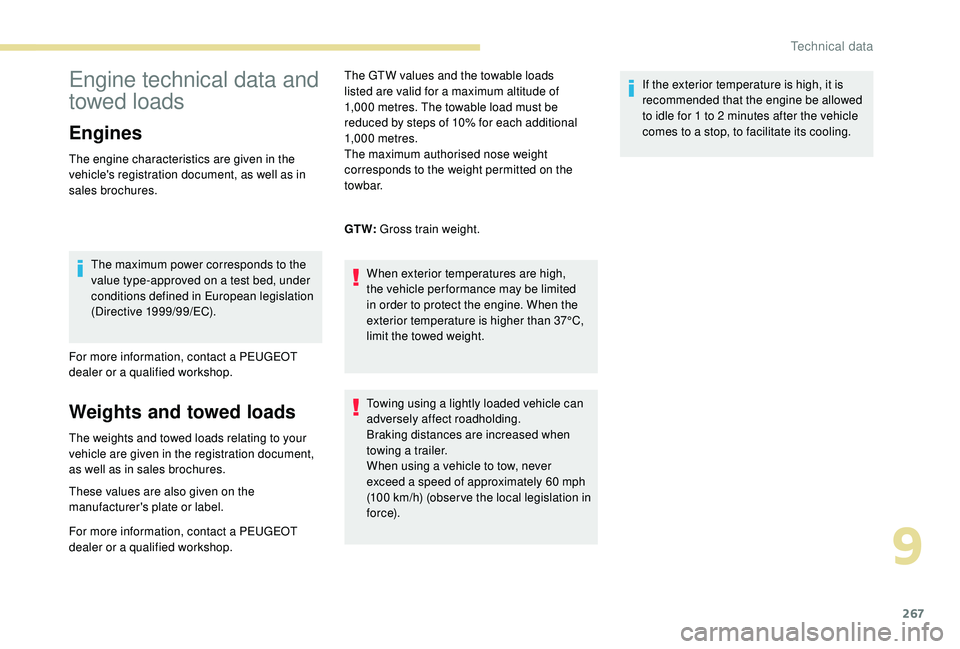
267
Engine technical data and
towed loads
Engines
The engine characteristics are given in the
vehicle's registration document, as well as in
sales brochures.The maximum power corresponds to the
value type-approved on a
test bed, under
conditions defined in European legislation
(Directive 1999/99/EC).
For more information, contact a
PEUGEOT
dealer or a
qualified workshop.
Weights and towed loads
The weights and towed loads relating to your
vehicle are given in the registration document,
as well as in sales brochures.
These values are also given on the
manufacturer's plate or label.
For more information, contact a PEUGEOT
dealer or a
qualified workshop. The GTW values and the towable loads
listed are valid for a
maximum altitude of
1,000 metres. The towable load must be
reduced by steps of 10% for each additional
1,000
metres.
The maximum authorised nose weight
corresponds to the weight permitted on the
towbar.
GT W: Gross train weight.
When exterior temperatures are high,
the vehicle per formance may be limited
in order to protect the engine. When the
exterior temperature is higher than 37°C,
limit the towed weight.
Towing using a lightly loaded vehicle can
adversely affect roadholding.
Braking distances are increased when
towing a trailer.
When using a
vehicle to tow, never
exceed a
speed of approximately 60 mph
(100
km/h) (obser ve the local legislation in
f o r c e). If the exterior temperature is high, it is
recommended that the engine be allowed
to idle for 1
to 2 minutes after the vehicle
comes to a stop, to facilitate its cooling.
9
Technical data
Page 270 of 364
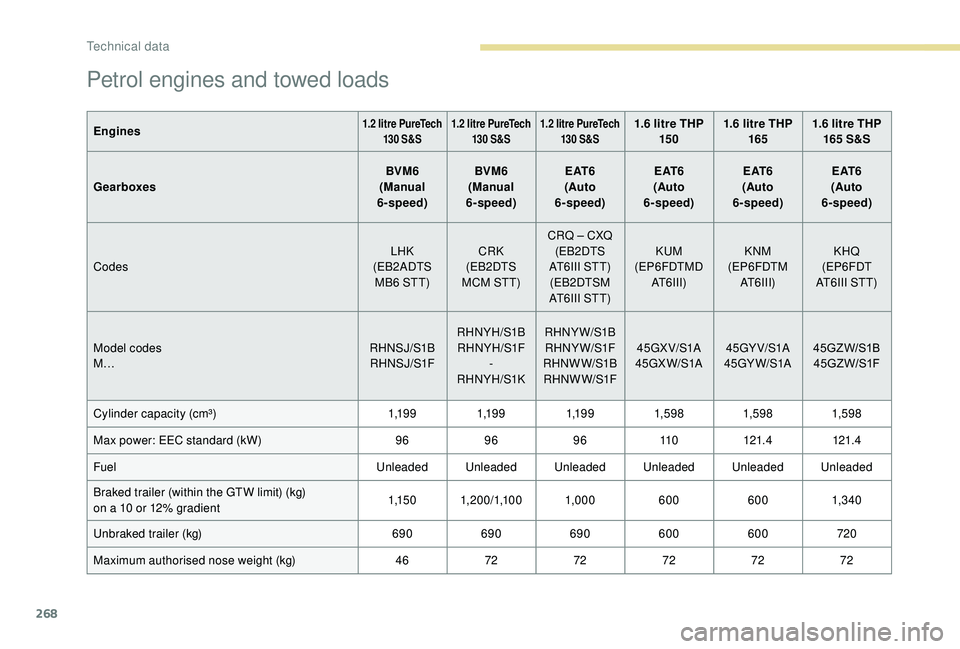
268
Petrol engines and towed loads
Engines1.2 litre PureTech
130 S&S 1.2
litre PureTech
130 S&S1.2
litre PureTech
130 S&S1.6 litre THP 15 0 1.6
litre THP
165 1.6
litre THP
165 S&S
Gearboxes BVM6
(Manual
6-speed) BVM6
(Manual
6-speed) E AT 6
(Auto
6-speed) E AT 6
(Auto
6-speed) E AT 6
(Auto
6-speed) E AT 6
(Auto
6-speed)
Codes LHK
(EB2ADTS MB6
STT) CRK
(EB2DTS
MCM STT) CRQ – CXQ
(EB2DTS
AT6III STT) (EB2DTSM
AT6III STT) KUM
(EP6FDTMD AT6III) KNM
(EP6FDTM AT6III) KHQ
(EP6FDT
AT6III STT)
Model codes
M… RHNSJ/S1B
RH NS J/S1F RHNYH/S1B
RHNYH/S1F -
RHNYH/S1K RHNYW/S1B
RHNYW/S1F
RHNW W/S1B RH NW W/S1F 45GX V/S1A
45GX W/S1A 45GY V/S1A
45GY W/S1A 45GZ W/S1B
45G Z W/S1F
Cylinder capacity (cm³) 1,1 9 91,1 9 91,1 9 91,59 8 1,59 81,59 8
Max power: EEC standard (kW) 96969611 0121.4 121.4
Fuel Unleaded Unleaded Unleaded Unleaded Unleaded Unleaded
Braked trailer (within the GTW limit) (kg)
on a
10
or 12% gradient 1,1 5 0
1, 20 0/1,10 0 1,0006006001,3 4 0
Unbraked trailer (kg) 690690690600 600 720
Maximum authorised nose weight (kg) 467272727272
Technical data
Page 271 of 364
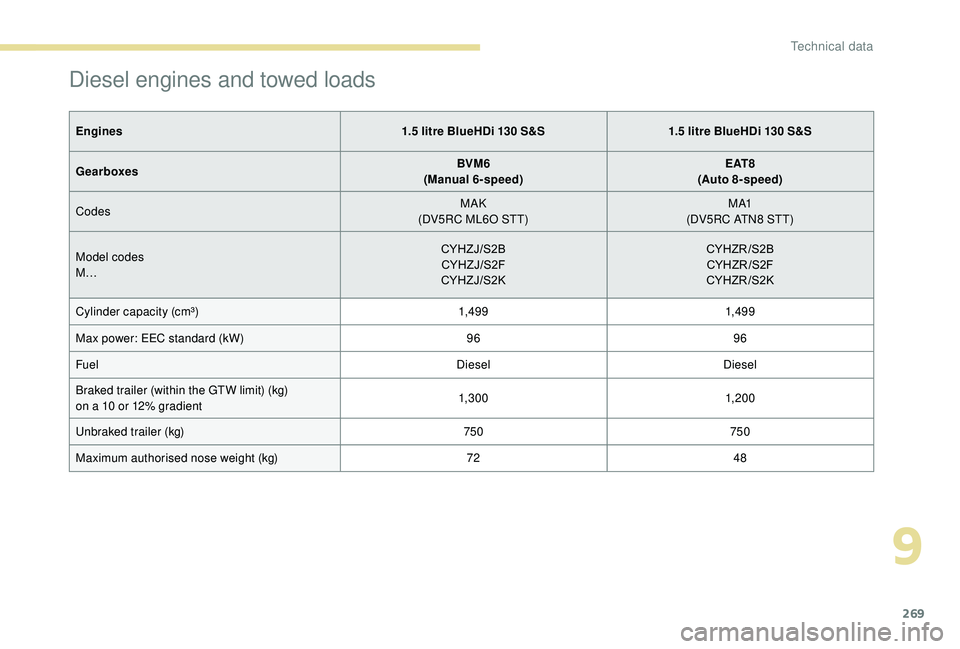
269
Diesel engines and towed loads
Engines1.5 litre BlueHDi 130 S&S1.5 litre BlueHDi 130 S&S
Gearboxes BVM6
(Manual 6-speed) E AT 8
(Auto 8-speed)
Codes MAK
(DV5RC ML6O STT) M A1
(DV5RC ATN8
STT)
Model codes
M… CYHZJ/S2B
CYHZJ/S2F
CYHZJ/S2K CYHZR /S2B
CYHZR /S2F
CYHZR /S2K
Cylinder capacity (cm³) 1,49 91,49 9
Max power: EEC standard (kW) 9696
Fuel DieselDiesel
Braked trailer (within the GTW limit) (kg)
on a
10 or 12% gradient 1,3 0 0
1, 20 0
Unbraked trailer (kg) 750750
Maximum authorised nose weight (kg) 7248
9
Technical data
Page 272 of 364
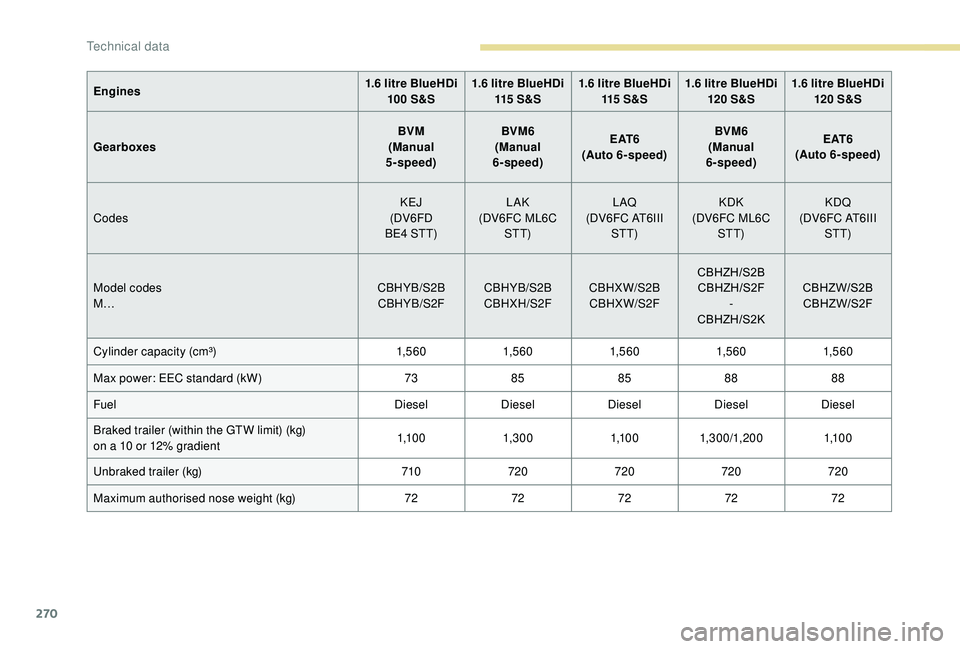
270
Engines1.6 litre BlueHDi
100 S&S1.6
litre BlueHDi
115 S & S1.6
litre BlueHDi
115 S & S1.6
litre BlueHDi
120 S&S1.6
litre BlueHDi
120 S&S
Gearboxes BVM
(Manual
5-speed) BVM6
(Manual
6-speed) E AT 6
(Auto 6-speed) BVM6
(Manual
6-speed) E AT 6
(Auto 6-speed)
Codes KEJ
(DV6FD
BE4
STT)LAK
(DV6FC ML6C STT) L AQ
(DV6FC AT6III STT) KDK
(DV6FC ML6C STT) KDQ
(DV6FC AT6III STT)
Model codes
M… CBHYB/S2B
CBHYB/S2F CBHYB/S2B
CBHXH/S2F CBHXW/S2B
CBHXW/S2F CBHZH/S2B
CBHZH/S2F -
CBHZH/S2K CBHZW/S2B
CBHZW/S2F
Cylinder capacity (cm³) 1,5 6 01,5 6 01,5 6 01,5 6 01,5 6 0
Max power: EEC standard (kW) 7385 8588 88
Fuel DieselDieselDieselDieselDiesel
Braked trailer (within the GTW limit) (kg)
on a
10 or 12% gradient 1,1 0 0
1,3 0 0 1,1 0 01,3 0 0/1, 20 0 1,1 0 0
Unbraked trailer (kg) 710720 720720720
Maximum authorised nose weight (kg) 7272727272
Technical data